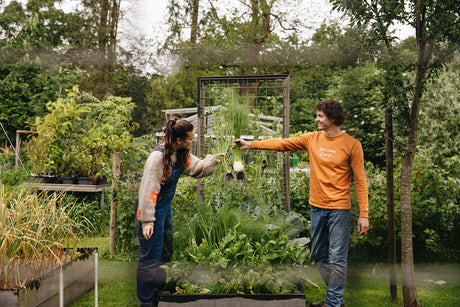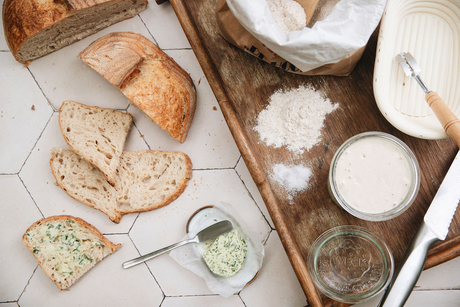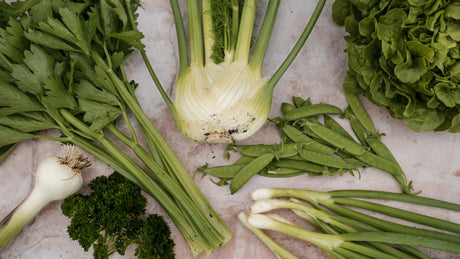Companion planting in the vegetable garden - 12 immediately applicable benefits
I have to admit, I have almost always used crop rotation up until now. I assume that planting everything in 1 bed is easier. Turn over with the Spade fork , put potatoes in or carrot seeds in and that's it. You also know very clearly what is where and the rest is weeds.
But now that I am doing some research on companion planting I have to admit that putting plants together and alternating them can be very valuable. Companion planting is a natural way of growing plants. In a forest or on an abandoned piece of land, not everything grows nicely in rows and beds. A mushroom grows close to the tree because it has an enormous water supply. Our farmer ancestors worked very often in companion planting. Their fields looked very confusing but if you looked a little closer you saw that everything was very refined and well thought out.
I will discuss companion planting extensively, but I will also regularly add my critical notes.
 Companion planting among the Indians
Companion planting among the IndiansCompanion planting back in time
The natives of America, the Indians, always planted corn , squash and beans in the same place. The corn let the beans climb and gave a light shade to the squash and. The beans (which are actually green manure) brought nitrogen into the soil for the corn . The squash crawled along the earth and made a kind of shield for weeds. A brilliant collaboration that
In parts of Asia, too, there was a golden trio. Cassava plants were combined with pole beans and ginger. The beans revolve around the cassava, providing shade for the ginger plants and producing nitrogen for their two neighbors. The aromatic and penetrating smell of the ginger roots drives away rodents that target the cassava plants.
After a lot of research, here are 12 reasons to start companion planting:
1. Free support
Climbing plants need support, think of melons, tomatoes, cucumbers , beans, peas, ... In monoculture or crop rotation we stretch ropes, place support poles or build other constructions. But if a sturdy plant like corn , sunflower, Jerusalem artichoke or a tree is willing to support your plant, then that is certainly welcome Critical note: Plants that are sensitive to mold, such as cucumber or melon, must still be able to get sufficient air circulation. Something that works perfectly when growing on climbing rope with tomato clips. Timing is also very important. The moment I plant my tomato plants in mid-May, the corn is not yet big and strong enough to support my fast-growing tomato plants . There is a big chance that one plant will pull the other over and that they will both fall to the ground in an intimate embrace. It is also difficult to find a good supporter for your peas in February-March. So think carefully about mold-sensitive plants, the timing of growth, strength of the plants, ...2. Companion planting improves taste and yield
Some plants grow much better and more productively when they are grown together with plants. A first reason can be that they help each other in terms of growing conditions and the nutrition they take in. If the plants have different feeding patterns for example. One plant can take nutrients from the soil which changes the biochemistry in the advantage of its neighbor. For example, Indian cress improves the flavor of radishes . Lettuce as a neighbor of radishes makes them milder in the summer. Tarragon and dill are ideal neighbors of cabbages because they improve the flavor. Sweet marjoram is combined with beans, eggplant , pumpkin and cucumbers because it increases the yield. An extensive list of which plants you can combine will follow.3. Combating diseases and pests (unwanted creatures)
We just read that tarragon , dill and marjoram improve soil chemistry. But many fragrant herbs function as insect repellents in the vegetable garden. Mint repels ants and cabbage whites. Lavender repels ticks. dill , one of the doctors of the vegetable garden
The beautiful Marigolds are effective against aphids and beetles that have their eye on your tomatoes, peppers or paprika 's. Yellow daffodils that you can plant out in flower bulbs early in the year can be planted around your root crops to keep voles, moles and other rodents at bay.
Critical note: I think you should sow your herbs and flowers very early and grow them indoors or buy vegetable garden plants in order to be on time to beat aphids, for example. I have had aphids on my berry bushes, broad beans and peas since April. For me, the best remedies against aphids are still the larvae of ladybirds . They eat 50 aphids a day and continue to hibernate in your vegetable garden. And with a bit of luck, they make a lot of babies :)
dill , one of the doctors of the vegetable garden
The beautiful Marigolds are effective against aphids and beetles that have their eye on your tomatoes, peppers or paprika 's. Yellow daffodils that you can plant out in flower bulbs early in the year can be planted around your root crops to keep voles, moles and other rodents at bay.
Critical note: I think you should sow your herbs and flowers very early and grow them indoors or buy vegetable garden plants in order to be on time to beat aphids, for example. I have had aphids on my berry bushes, broad beans and peas since April. For me, the best remedies against aphids are still the larvae of ladybirds . They eat 50 aphids a day and continue to hibernate in your vegetable garden. And with a bit of luck, they make a lot of babies :)
4. Some plants attract unwanted critters away from their neighbors
There are plants that attract pests away from their neighbors. Other plants attract the enemies of your unwanted creatures. Zinnias are planted near cauliflower because they attract ladybugs that eat the aphids, cabbage flies, and other pests that target your cauliflower .5. Companion plants that provide shade
Most plants can't get enough sun. But others can't handle it well or they benefit from the soil not drying out from a bright sun. Not only shade-loving plants but also young plants don't like full sun. Radishes and spinach are good friends. The large leaves of the fast-growing radishes protect the young spinach plants that cannot yet go deep into the ground with their roots in search of water. Once the radishes are mature, you can harvest them and the spinach plants can continue to grow quickly. Mint among the coals repels cabbage whites
Mint among the coals repels cabbage whites6. Plants that help pollinate
Plants that attract bees and butterflies are ideal for helping to pollinate fruits and vegetables. Fruit set is much better and yield increases. Asters , Bergamot, Zinnias and Yarrow are ideal for attracting pollinating insects.
7. Better use of your space
Some plants are tall and narrow, other bushes a bit more ( bush beans ). The root system is also different. Lettuce gets its nutrition from the top layer of your garden, while corn searches much deeper. Many plants can live together without hindering each other. Pay close attention to the timing of the crops and the depth of their root system. On the crop cards that you reach via the menu of this site, you can read how deep the root system of plants is. If something is harvested, put something in its place, with some extra compost or universal fertilizer granules the new plant will be off again immediately. companion planting in the vegetable garden
companion planting in the vegetable garden8. Promoting soil health
Legumes have the ability to make nitrogen available to the plants in your soil. Plants that need a lot of nitrogen benefit from having legumes as neighbors.9. To brighten up less beautiful areas
In ornamental gardens, companion planting is often used to mask less attractive parts of a plant. Think of marigolds that are planted at the base of roses to brighten up the previously unsightly, sticky base of the rose plants. The marigolds also repel unwanted animals, especially aphids, which love to sit on the underside of your rose leaves to feed on the juices of your plant.10. Suppressing weeds
Many creeping plants help to keep your vegetable garden weed-free. Sweet potato is a very good example. Pumpkins also grow like crazy and block weed seeds and sun rays from each other. The creeping plants go well with bush beans that stretch a bit if necessary to come above the creepers.
 The sweet potato plant suppresses weeds
The sweet potato plant suppresses weeds







